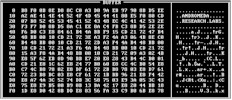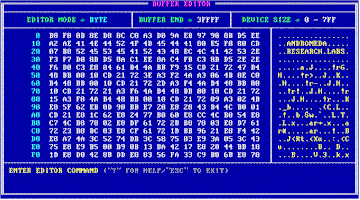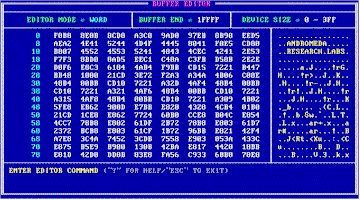DATA COMMANDS
Modify buffer
- This command allows you to modify any
location(s) within the buffer. Buffer position is
identified by a reverse video cursor positioned
by page up, page down, home, end and arrow keys.
Data may be entered in hex, binary, octal,
decimal or ASCII. ASCII may be entered at any
time by pressing tab. Other number bases are
selected with the "set number base"
command.
Transfer data
- Transfers (block move) data from any location
to any other location within the buffer.
Clear buffer
- Initializes buffer contents to 00 or FF hex.
Display buffer
range or page - Positions the
editor window to any place within the buffer or
scrolls through a specified range of addresses.
Fill buffer with
a constant - Fills a specified
address range with a constant value. The value
can be either byte or word depending on the
buffer mode.
Checksum
- Allows you to calculate a checksum over any
buffer address range.
Logical
operations - Performs AND, OR and
XOR operation of buffer data with a constant over
a specified address range. Supports both byte and
word values. Also performs INVERT.
Byte/Word data
manipulation - Allows you to
select from one of four options. (1) Byte swap -
Performs a swap of hi and low (odd/even) bytes in
the buffer. (2) Nibble swap - Swaps the hi and
low nibbles of each byte. (3) Extract Even Words
- Extracts words at even word addresses only. (4)
Extract Odd Words - Extracts words at odd word
addresses only.
|
DEVICE
COMMANDS
Single byte
program - Programs one or more
single bytes into the device installed in the
programming unit.
Inspect
- Allows you to inspect (read and display) the
contents of a device installed in the programming
unit without placing the data in the buffer. This
command also has an option to inspect, compare
and show differences between the device contents
and buffer data.
Quick view device contents
- Allows you to view the device contents on the editor screen without reading the data into the buffer. This is a quick way to determine if a part is correctly connected to the system.
Read device into
buffer - Allows you to read the
contents of a device into the buffer at any
address or adderss 0.
Program device
from buffer - Allows you to
program a device from buffer data over a
specified address range or address 0.
Compare device
with buffer - Compares and shows
differences between the device contents and the
buffer data. Also used for confirming data in the buffer matches the data in the part.
Write data to
device - Writes data from any
range of addresses in the buffer to any locations
in the device. The write command differs from the
program command in that the program command
always starts at physical address 0 in the
device.
Zone read
- Allows data from any range of device addresses
to be read into the buffer at a user specified
address.
|
UTILITY COMMANDS
Search buffer
for hex or ASCII pattern -
Searches the buffer for a specific hex or ASCII
pattern. If the pattern is located the search
halts with the match addresses displayed. You are
given the option to modify,
exit or continue
to search for another occurance.
Set editor mode
to byte or word - Sets the editor
display and entry formats to byte or word values.
Set display /
entry number base - Allows you to
set the number base used in the editor. You may
set the editor to accept and display data in hex,
decimal, octal, binary and ASCII.
Hex arithmetic
- Allows you to add, subtract, multiply and
divide hex integer values.
Bipolar prom
format convert - Changes the
buffer from byte values to fuse (bit) values and
back. This command is used with bipolar proms to
work with individual fuse elements in the memory
array.
Get Confirmed Data
- Invokes an automated procedure by pressing a single key (G) which results in valid (confirmed by read/compare) data in the system buffer. This command is primarily used with in-circuit reading of serial eeproms.
Help screen - The editor has an on-line command summary which
can be displayed at any time. The command summary
describes each command and how it is used. |


